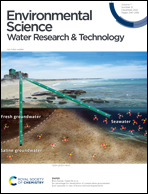Filter-less separation technique for micronized anthropogenic polymers from artificial seawater
Abstract
Anthropogenic polymer particulates (APPs) are a highly researched topic, from the identification of their different sources to their impact on living organisms, and micronized anthropogenic polymers pose a threat to many ecosystems. Prevalently found are microplastics (MPs) including PMMA. Additionally, micronized rubber powder (MRP), which originates from tire abrasion but is also used as a filler material for various other products, can be found. Due to their small size of less than 100 μm in diameter and relatively low concentrations found in wastewater or seawater, the cleaning from such water sources of MPs or MRP will only be of technological and economic relevance if an efficient, low cost pre-concentration step can be applied before other filtration/separation technologies are applied. Flotation is expected to be such a relevant pre-concentration technique if a high enough affinity of MP/MRP particles to gas bubbles would exist. Accordingly the interaction behavior of MRP and MPs with such gas bubble interfaces was investigated. Based on this, a simple, fast and filter-less technique was developed to remove APPs from seawater by a newly designed process combining flotation and separation in a hydrocyclone type setup. In a first step, we characterized the MRP and found two particle fractions with different gas bubble interaction behaviors. One fraction formed spontaneous air bubble–particle clusters and was prone to attach to the air–water interface. The second fraction sedimented and accumulated at the bottom. Once adsorbed at the interface, the particles remained irreversibly attached. Both MPs and MRP stabilized the foams from air bubbles in artificial seawater as well as in MilliQ water, indicating a preferred localization at the air–water interface. Thus, when treated in the modified hydrocyclone (mHC) based flotation process with controlled swirl flow applied, an extraction ratio of 26% was reached, whereas without bubbles, only 3.7% was reached. The investigated model mHC enabled us to concentrate and separate APPs, in the diameter range d90,3 ≤ 105 μm with particle density very close to water, with the use of their promotion of the air–water interface. These promising results in a first test step for our system encourage further investigation of the applied technology for microplastic-contaminated water.



 Please wait while we load your content...
Please wait while we load your content...